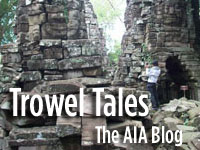The Monkey, the Whale and the Nasca Lines
by Heather Pringle
February 26, 2010
 I read with great sadness this morning of a small plane that crashed yesterday while taking tourists on an aerial tour of famous Nasca Lines in Peru. According to the online report, seven people—three Chileans and four Peruvians—perished aboard a small Cessna aircraft.  Witnesses said that the plane was destroyed on impact, meaning that it will likely take some time to sift through the wreckage and piece together what went wrong.
I read with great sadness this morning of a small plane that crashed yesterday while taking tourists on an aerial tour of famous Nasca Lines in Peru. According to the online report, seven people—three Chileans and four Peruvians—perished aboard a small Cessna aircraft.  Witnesses said that the plane was destroyed on impact, meaning that it will likely take some time to sift through the wreckage and piece together what went wrong.
This is, of course,  tragic news for the families of the passengers,   and yet another hard blow to the archaeological tourism industry in Peru, already reeling from the devastation and loss of human life caused by recent mudslides at Machu Picchu. And in the aftermath of both, I am sure there will be a lot of soul-searching. Was the Peruvian government at fault in the case of the mudslides, failing to replant mountainside forests need to anchor the soil on steep slopes? And did the owners of the small plane observe all necessary safety precautions before that Cessna taxied down the runway.
I certainly don’t have any answers, but what I can say is that the aerial tour over the Nasca Lines is one of the most exhilarating and wondrous flights available to those of us who love archaeology.  I had the immense good fortune to take it while I was researching an article on the Nasca culture for another magazine, and I have never forgotten it. And I think the circumstances bear repeating.
I was travelling at the time with a photographer, and we spent our first week on the ground in the Nazca region with a team led by Persis Clarkson, an archaeologist at the University of Winnipeg in Canada, who was photographing and sketching sherds that littered some  lines. (For those unfamiliar with the Nasca culture, I should quickly mention that it  flourished from around A.D. 1-750 and comprised agriculturalists who sowed corn and other crops along rivers that carried meltwater from the Andes.)  Clarkson hoped that the ceramic styles of the sherds would help date  the lines.  It was hot, bleak work trudging over the  desert, and it gave me little sense of the complex lattice of lines there.  So I was raring to take to the air.
The photographer and I booked a small four-seater aircraft and arrived at the airstrip the next morning before dawn. We had arranged for one of the doors to be taken off for an unencumbered photographic shoot.  The owner had kindly obliged, but when the photographer climbed into the backseat, he discovered there were no seatbelts—a problem for someone who planned to hang out of the plane.  On learning of this, the mechanic disappeared into a small hangar and emerged with a length of stout rope: he then wrapped it several times around the photographer and the seat and knotted it, securing him firmly in place. The photographer still wasn’t satisfied: he asked me to pass him his pack containing a Swiss army knife, for a quick release if necessary.
Seated in the plane, we waited for the pilot to appear. As the sun began to rise, I spotted a small figure strolling towards us down the runway. He had a long white silk scarf wrapped once around his neck, like a World War One flying ace, and possessed the good looks of an matinee idol.  He looked young, no more than a teenager, far too young to be a pilot. But as he approached, he circled the plane once for a visual inspection, then climbed in and immediately started the aircraft, taxiing down the runway.
I confess I was apprehensive. But as we took to the air, the sun rose above the horizon, sending its first silvery light slanting across the desert floor. Below us, as we climbed, the tracery of ancient lines stood out in crisp relief from the grey ground. At the photographer’s request, the pilot turned tight, perfect little spirals around the famous figures of the monkey and the whale. Then he leveled out and we soared over a plain etched by lines that ran straight and true for kilometers until they faded into ghostly grey.
It was a perfect flight. And as I later discovered,  the young pilot was older than he looked: he had trained in the Peruvian airforce. This morning, as I read the account of the crash, I remembered his faultless handling of the plane.  I was very sorry to hear of yesterday’s loss of life, and I do hope that Peruvian authorities will get to the bottom of the problem so that yesterday’s crash will not deter others from this incredible experience.
Comments posted here do not represent the views or policies of the Archaeological Institute of America.






 Heather Pringle is a freelance science journalist who has been writing about archaeology for more than 20 years. She is the author of Master Plan: Himmler's Scholars and the Holocaust and The Mummy Congress: Science, Obsession, and the Everlasting Dead. For more about Heather, see our
Heather Pringle is a freelance science journalist who has been writing about archaeology for more than 20 years. She is the author of Master Plan: Himmler's Scholars and the Holocaust and The Mummy Congress: Science, Obsession, and the Everlasting Dead. For more about Heather, see our 



